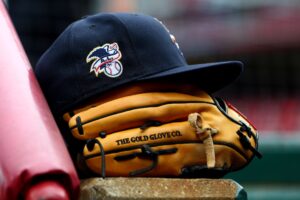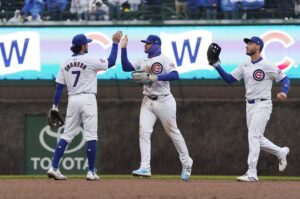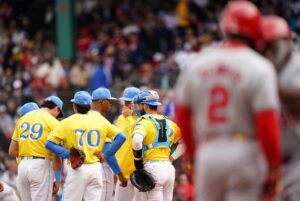The year is 2007. The Atlanta Braves, fresh off their first losing season since 1990, sit with a record of 55-51 towards the end of July. The team is undeniably talented, led by future HOF players in Chipper Jones and John Smoltz, but it is clear a change is needed. Eager to return to the postseason, Atlanta pulls the trigger on a massive, blockbuster trade ahead of the deadline.
The Braves gave up five players to bring in slugging first baseman Mark Teixeira and pitcher Ron Mahay. While both players performed well in Atlanta, the end result of a trip to the postseason was not realized. The Braves missed the playoffs by five games in 2007 and fell back below .500 in 2008. Additionally, Teixeira was traded one year later as Atlanta realized it would not re-sign him in free agency. This article will look back on the decision to acquire Teixeira while pinpointing where Atlanta went wrong.
Revisiting the Mark Teixeira Trade
What Atlanta sent in the trade
The Texas Rangers received an impressive haul in the deal to ship away their All-Star first baseman. The biggest chip, Elvis Andrus, remains a key piece to Texas’ roster. He has four, 4.0 WAR seasons with the franchise since his debut and is signed through 2022. The other position player received in the deal, Jarrod Saltalamacchia, played parts of four seasons with the Rangers. Though he never stuck as a long-term option, Saltalamacchia did hit 19 home runs while appearing in 193 games with Texas.
Texas also received three pitchers in the transaction: Matt Harrison, Neftali Feliz, and Beau Jones. Jones would never make it to MLB, but the other two proved valuable for the Rangers. After debuting in 2008, Harrison would go on to pitch in parts of eight seasons for Texas. Though he experienced a rocky start, Harrison did post a 3.38 ERA and 399 innings pitched in 62 starts between 2011-12. Meanwhile, Feliz debuted in 2009 and quickly found his role as Texas’ closer. From 2009-14, Feliz appeared in 198 games with a 2.53 ERA, 226 strikeouts, and 87 saves. Feliz also posted a 1.93 ERA over 18 postseason appearances with the Rangers.
What Atlanta received in the trade
In return, the Braves received Teixeira and a veteran left-handed reliever in Mahay. Based on their performances in Atlanta, the Braves came out of the deal okay. Mahay put up a 2.25 ERA in 30 games with Atlanta during 2007 before leaving after the season. Teixeira provided exactly the offensive punch the Braves were hoping for. In 54 games during the stretch run of 2007, “Tex” put up a slash line of .317/.404/.615 with 17 home runs, 56 RBI, 38 runs scored, and nine doubles. He followed the same trajectory over the start of the 2008 season before being traded away. For his time in Atlanta, Teixeira appeared in 157 games and hit .295/.395/.548 with 37 home runs, 134 RBI, 36 doubles, and 101 runs scored.
The problem for Atlanta was not in the results provided by these two players but in the team results as a whole. The Braves missed out on the playoffs in 2007 and were nowhere close to contention in 2008. Without a chance to compete for a championship, Atlanta would eventually trade Teixeira to the Los Angeles Angels for first baseman Casey Kotchman and a minor league player. Needless to say, the short amount of time left on Teixeira’s deal severely hampered Atlanta’s return for the star slugger.
What Atlanta did wrong
As previously stated, the problem never was in the performances of Teixeira or Mahay. The problem lied in Atlanta’s decision-making from the start. Yes, Atlanta improved its offense by adding Teixeira, but management failed to address the team’s biggest weakness – the rotation.
In 2007, Atlanta boasted a formidable one-two punch at the top of the rotation with Tim Hudson and Smoltz. Both pitchers made at least 32 starts with 200 innings pitched an ERA in the low three’s, and well over 100 strikeouts. Unfortunately, the rotation past these two stars was a rotating cycle of journeyman and Triple-A quality starters. Buddy Carlyle had a 5.21 ERA over 20 starts. Kyle Davies saw a 5.76 ERA over 17 starts. Jo-Jo Reyes, Mark Redman, and Lance Cormier combined for 24 starts, but none of these pitchers had an ERA below 6.22.
Last Word
Atlanta’s decision to go “all in” with the 2007 team was a questionable one at the time. What was downright bewildering was the decision to beef up the offense while ignoring the biggest hole on the roster. Not only that, but the Braves paid for the decision in 2008 as the rotation battled injuries and various struggles on their way to another disappointing finish. Yes, Teixeira was a great player in a Braves uniform, but he was never going to be the solution to Atlanta’s problems. That is why this trade goes down as a big miss for the Braves.
Main Photo:
Embed from Getty Images






